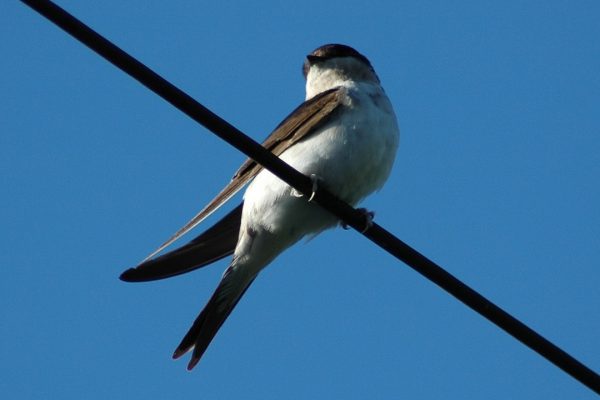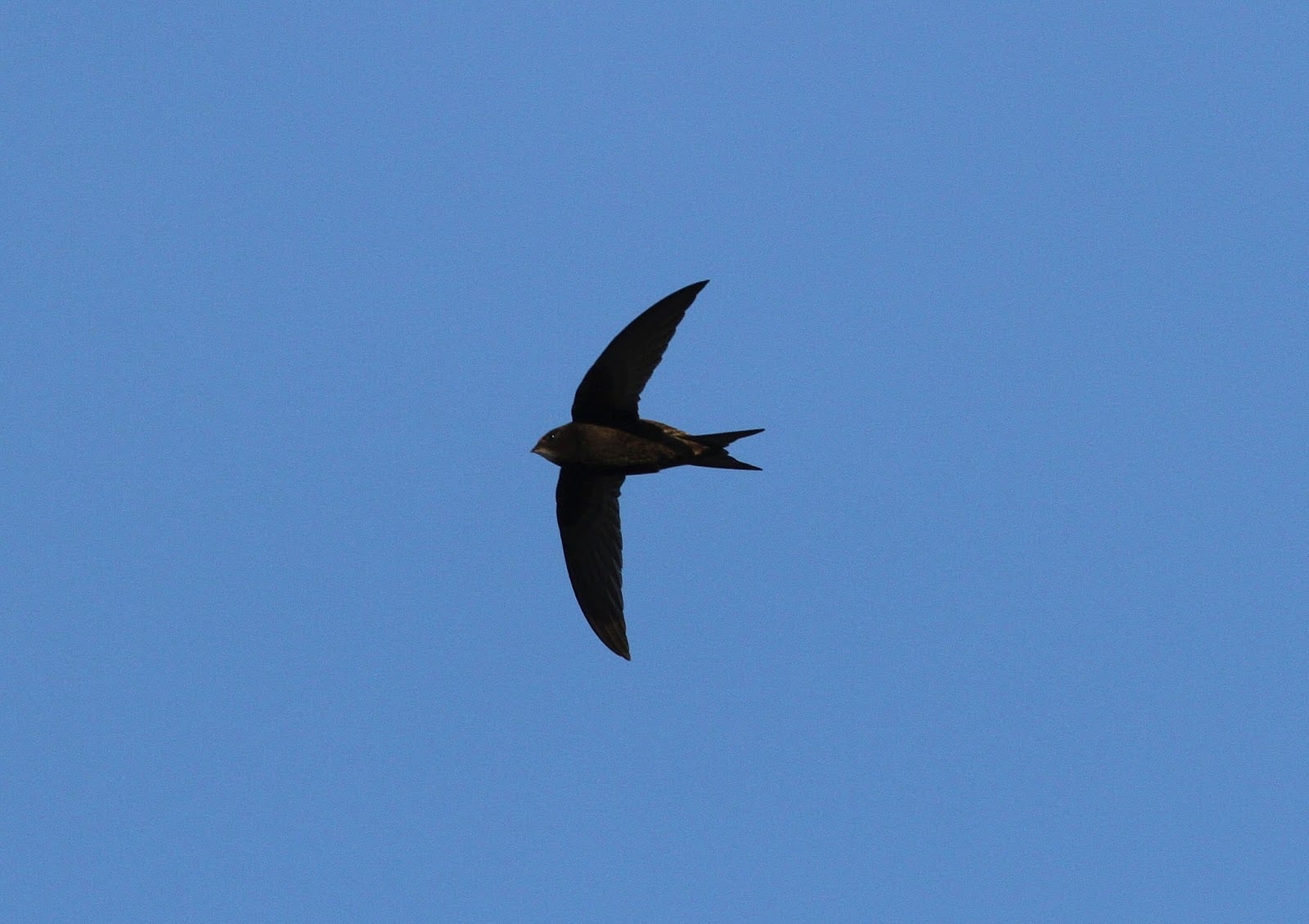
House Martin
| Irish Name: | Gabhlán Binne |
| Scientific name: | Delichon urbicum |
| Bird Family: | Swallows & Martins |
amber
Conservation status
Conservation status
Status
Common summer visitor throughout Ireland from mid-March to late-September.
Identification
Between Sand Martin and Swallow in size. In all plumages has a large white rump, a feature not shown by either Sand Martin or Swallow. The flight is also different, gliding frequently on extended, almost triangular wings. Has a shallow tail fork like Sand Martin. Adult House Martins have a glossy black head, back, wings and tail, contrasting markedly with the pure white underparts. In juveniles, the upperparts lake the glossy sheen, while the underparts are washed grey-brown.
Voice
Rather vocal. The most frequently heard call is a dry “prittt”. Has a rather primitive song of various squeaky notes mixed with call-notes.
Diet
Like Swallows and Sand Martins, House Martins feed on insects such as aphids and mayflies caught in flight.
Breeding
Similar to Swallow, the House Martin constructs a nest out of mud. It is usually sited underneath the eaves of a house. Also nests on cliffs. Usually raises between two or three broods every year, with some fledging as late as October.
Wintering
Winters in tropical Africa.
Monitored by
Blog posts about this bird

Wildlife in Buildings documentary
[vc_row type="in_container" full_screen_row_position="middle" scene_position="center" text_color="dark" text_align="left" overlay_strength="0.3" shape_divider_position="bottom" shape_type=""][vc_column column_padding="no-extra-padding" column_padding_position="all" background_color_opacity="1" background_hover_color_opacity="1" column_link_target="_self" column_shadow="none" column_border_radius="none" width="1/1" tablet_width_inherit="default" tablet_text_alignment="default" phone_text_alignment="default" column_border_width="none" column_border_style="solid"][vc_column_text]
Certain species are expected residents within our buildings, and for some the association with buildings is apparent even from their names, such as the ‘House Martin’ which builds its mud nest in the apex of the roof of occupied houses, and the ‘Barn Swallow’ which travels from Africa to nest in farmyards throughout the country. The vision of a Barn Owl floating silently from a ruined castle at dusk may seem familiar, but less expected occupants may be a pair of Kestrels nesting in a flower box outside a busy kitchen window, or a female Pine Marten raising her kits in the roof space of an occupied dwelling. Of course, much of the wildlife which use buildings go unnoticed, such as bats roosting in the attic of a house in which the inhabitants beneath remain blissfully unaware of their presence.
Given the importance of buildings for wildlife, changes to the built environment can affect wildlife associated with it. Wildlife in buildings can often be harmed during works due to a lack of awareness of their presence or indeed knowledge of how plan renovations and works in order to avoid disturbance, which is usually always possible. The loss of old stone structures due to demolition, dilapidation or renovation is linked to declines in species such as Barn Owl and Swift, which are dependent on these structures. Modern buildings do not provide the same opportunities for wildlife. However, there is a lot that we can do to improve modern buildings for wildlife to ensure that we continue to make space for nature.
BirdWatch Ireland and CrowCrag Productions in partnership with Laois County Council, Clare County Council and Tipperary County Council and supported by the National Biodiversity Action Plan Fund of the Department of Housing, Local Government and Heritage have produced a nature documentary to celebrate the wildlife which have taken up residence in the built environment, and to showcase some of our most iconic wildlife species which are reliant on buildings for their survival.
John Lusby, BirdWatch Ireland, commented, ‘We wanted to celebrate the importance of buildings for wildlife and to create a better link between our built heritage and our natural heritage – as the two are intertwined. The diversity of species which use buildings, and the ways in which they have adapted to use the built environment, is truly astonishing. As the built environment is constantly changing, we need to make sure that we avoid disturbance to sensitive species and also to continue to provide space for wildlife in buildings, which has benefits for wildlife as well as ourselves. We hope that this feature increases awareness and appreciation of the importance of the built environment for wildlife and provides the necessary information to help conserve some of our most vulnerable and iconic wildlife which are dependent on buildings for their survival’.
Roisin O’Grady, Heritage Officer with Tipperary County Council said ‘We share the world with nature and it can be closer to us than we think. Tipperary County Council is delighted to support this film highlighting the importance of our built environment, heritage or otherwise in providing shelter for such a variety of species, some of which are our most vulnerable. Given the high levels of habitat loss we have experienced over the last number of years it is more important than ever to be aware of how species have adapted to our built environment and how we can support this ‘co-habitation’ and equally important in newer development how we ‘make space’ for nature’.
Congella McGuire, Heritage Officer with Clare County Council commented ‘The Local Authority Heritage Officer Network is delighted to be associated with this Wildlife in Buildings video and the guidance booklet ‘Wildlife in Buildings: linking our built and natural heritage’ both of which were produced with the support of the Local Authorities and National Biodiversity Action Plan Fund’.
The video ‘Wildlife in Buildings: linking our built and natural heritage’ is available to view below or here: https://www.youtube.com/watch?v=5lQt3C8uI5E This video accompanies the guidance booklet on Wildlife in Buildings, which is available here: https://www.kerrycoco.ie/wildlife-in-buildings/
‘Wildlife in Buildings: linking our built and natural heritage’ was produced by BirdWatch Ireland, Kerry County Council and Donegal County Council, with funding from the Department of Housing, Local Government and Heritage through the National Biodiversity Action Plan Fund.
https://www.youtube.com/watch?v=5lQt3C8uI5E&t=782s[/vc_column_text][/vc_column][/vc_row]





 A ruined Abbey which is used by a wide range of wildlife © John Lusby
A ruined Abbey which is used by a wide range of wildlife © John Lusby Swift © Artur Tabor, Lesser Horseshoe Bat © Ruth Hanniffy
Swift © Artur Tabor, Lesser Horseshoe Bat © Ruth Hanniffy There are many ways we can improve modern buildings for wildlife such as this example, where a purpose built Barn Owl nest site was incorporated in the building
There are many ways we can improve modern buildings for wildlife such as this example, where a purpose built Barn Owl nest site was incorporated in the building  Kestrel in flight © Michael O'Clery, Kestrel nest in castle © John Lusby
Kestrel in flight © Michael O'Clery, Kestrel nest in castle © John Lusby Renovations and other works on buildings can have unintended consequences for wildlife if not planned appropriately © Conor Kelleher
Renovations and other works on buildings can have unintended consequences for wildlife if not planned appropriately © Conor Kelleher Workhouse in ruins © Michael O'Clery, Barn Owls in chimney nest © John Lusby
Workhouse in ruins © Michael O'Clery, Barn Owls in chimney nest © John Lusby


